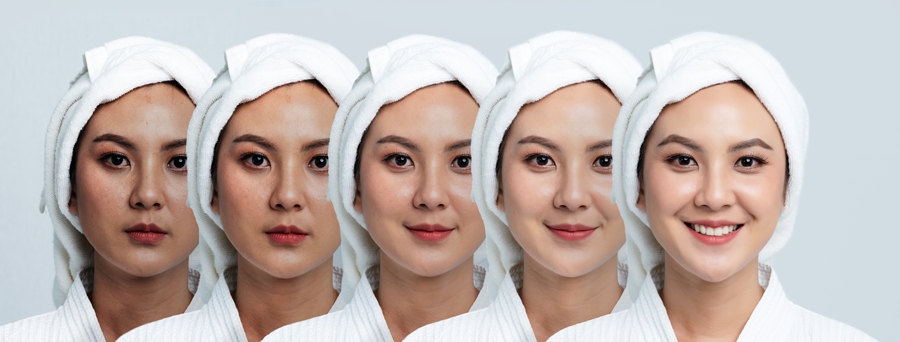A New Approach for Melasma
Written by Dr. Wade ChengMelasma (also known as chloasma) is a common skin problem. The condition causes dark, discolored patches on skin. It typically occurs on the face, particularly the forehead, cheeks, and above the upper lip. The dark patches often appear on both sides of the face in a nearly identical pattern. The darker-colored patches of skin can be any shade, from tan to deep brown. Rarely, these dark patches may appear on other sun-exposed areas of the body.
Melasma is thought to be caused by sun exposure, genetic predisposition, hormonal changes, and skin irritation. Although it can affect anyone, melasma is particularly common in women (over 90%), especially pregnant women, during menopause, and those who are taking oral contraceptives or hormone replacement therapy medications. Hence, melasma is also known as the mask of pregnancy.
The dark patches typically last until the end of pregnancy or discontinuation of hormonal medications and with sun protection. The patches gradually fade over many months. In some people, the discoloration never entirely disappears.
A few options may help fade or treat melasma:
- Using a topical product containing hydroquinone to lighten the hyperpigmented area.
(Products with a higher concentration of hydroquinone (4% to 5%) are available with a doctor’s prescription.)
- Using tretinoin, which is a type of vitamin A that helps to increase the rate at which dead skin cells fall off and new ones appear. This makes the melasma patch fade more quickly as the pigmented cells are shed.
- Using a cream containing azelaic acid, which can slow down the production of melanin, which makes the melasma darker.
- Using chemical peels, such as a glycolic acid solution and lactic acid solution, to provide a mild skin exfoliation. Over time, the skin layers with dark color peel off, leaving fresh, new skin.
- Using laser or intense pulsed light therapy (IPL) in which certain wave lengths of light are applied to remove pigmented areas of skin. It is costly (average $500 to $600 per treatment) and multiple treatments are needed.
These methods have some disadvantages, such as limited improvement, slow process (takes a long time to show improvement), hyperpigmentation recurrence, and cost.
Recently, there is a new, elegant aesthetic approach for melasma available on the market. The treatment product utilizes a series of active ingredients, such as micronized pearl powder (melanin absorbent), ascorbic acid (vitamin C, an antioxidant), and kojic acid (antioxidant), ginkgo extract, cysteine (antioxidant), and sodium metasulfite (inorganic antioxidant). The treatment product is dry powders packed in an airtight glass vial to preserve the maximum potency of its antioxidants. The treatment product is mixed with a clay mask (bentonite for good skin penetration) in an appropriate ratio to achieve a substantially high concentration of the active ingredients. Moreover, a few drops of vitamin P (bioflavonoid) serum are added to enhance the potency of vitamin C (there is a synergistic effect for vitamin C with vitamin P).1 The mixture is applied immediately (after mixing) to the melasma area only and remains for 20 to 25 minutes (longer is better).
Moreover, microdermabrasion, dry needling (cosmetic tattoo machine with round 3 to 5 needle – light and loose puncture), derma pen, or even light scratching with a big round tattoo needle (manually) should be performed before the application of the mixture to insure sufficient skin penetration of the active ingredients. This is one of the key factors to make the treatment very effective.
This professional treatment appears to be quite effective and usually a noticeable difference can be observed immediately after a treatment.
This treatment can be performed two or three times per week. A concentrated vitamin C serum (10%) and a facial sun block (SPF 40) should be used in daytime. A lightening serum featured with arbutin, vitamin C derivative, ascophyllum nodosum (Norwegian kelp extract to reduce melanocyte activity), and licorice extract should be used nightly.
With the treatment and designated homecare, a significant improvement of a melasma can be achieved after five or six treatments.
This anti-melasma treatment with a good homecare regimen is thoughtfully and cleverly designed to achieve a good improvement for melasma disorder. It is a relatively more effective technique than most other melasma homecare or professional treatments. This technique is a non-aggressive process and no melasma recurrence has been observed thus far.
The new aesthetic technique can provide a definite solution for tough melasma problems and can restore healthy skin and beautiful appearance for many women suffering from this unsightly skin disorder.
References
1 Cheng, Wade. “Vitamin P and Skin Care.” DERMASCOPE Magazine 25, no. 10 (2000):
121-124.

Wade Cheng is CEO and director of research and development, Rejuvi Laboratory Inc. Prior to this position, he was a senior research chemist on Smithkilne Beckman Corporation, California Public Health Department, and Bio-Rad Laboratories. He holds a bachelor of science degree in chemistry and chemical engineering. He also holds a master of science degree in analytical chemistry from the University of San Francisco and has a Ph.D. in biochemistry from the University of California-Davis. He has over 100 publications in many scientific journals and magazines.

Dave Rosprim is the director of marketing at Rejuvi Laboratory Inc. He holds a bachelor of science degree in electrical engineering from the University of California-Berkeley and a master of science degree in electrical engineering from Stanford University.
